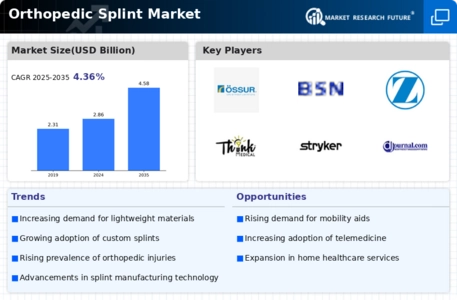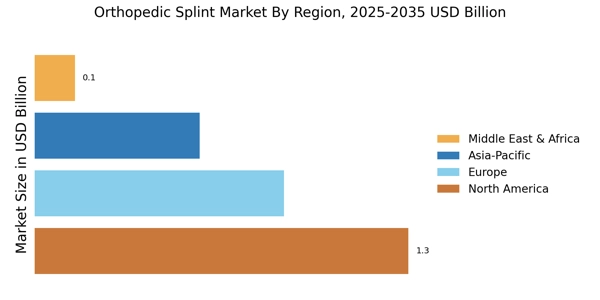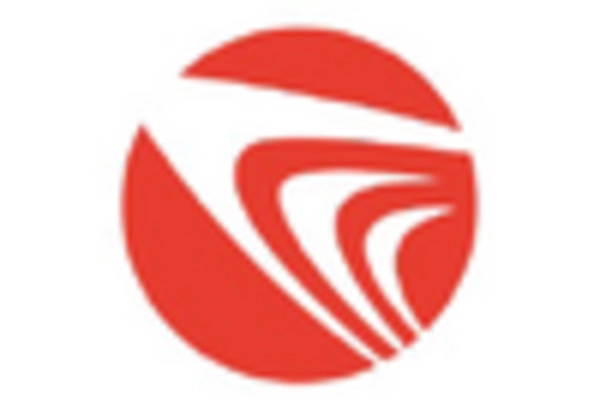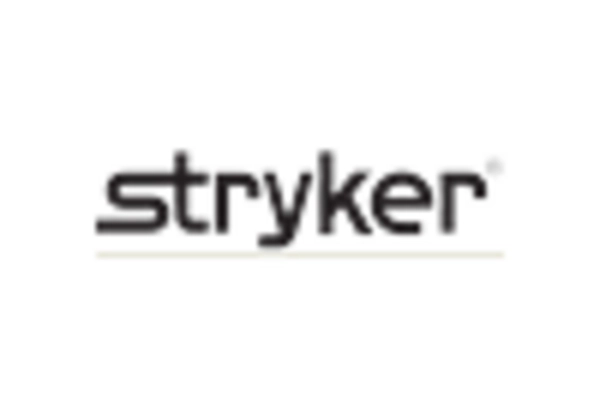Rising Geriatric Population
The aging population is a significant factor influencing the Orthopedic Splint Market. As individuals age, they become more susceptible to injuries and musculoskeletal disorders, which increases the demand for orthopedic splints. Data indicates that the geriatric population is expected to grow substantially in the coming years, leading to a higher incidence of conditions that require splinting. This demographic shift necessitates the development of specialized orthopedic products tailored to the needs of older adults. Consequently, the orthopedic splint market is likely to experience growth as healthcare providers seek to address the unique challenges posed by an aging population, ensuring effective treatment and improved quality of life.
Expansion of Healthcare Infrastructure
The expansion of healthcare infrastructure in various regions is a crucial driver for the Orthopedic Splint Market. As healthcare facilities grow and improve, access to orthopedic care becomes more widespread, leading to an increased demand for orthopedic splints. Investments in hospitals, clinics, and rehabilitation centers are facilitating better patient care and treatment options. Additionally, the establishment of specialized orthopedic units within healthcare systems is likely to enhance the availability of splinting solutions. This expansion not only supports the treatment of existing conditions but also encourages preventive measures, thereby fostering a favorable environment for the orthopedic splint market to thrive.
Technological Innovations in Splint Design
Technological advancements in the design and materials used for orthopedic splints are significantly influencing the Orthopedic Splint Market. Innovations such as lightweight materials, customizable designs, and enhanced comfort features are attracting both healthcare professionals and patients. For instance, the introduction of 3D printing technology has enabled the production of personalized splints that cater to individual anatomical needs. This not only improves patient compliance but also enhances recovery outcomes. The market is witnessing a shift towards more sophisticated splinting solutions, which could potentially lead to a surge in demand as healthcare providers adopt these advanced products to improve patient care.
Increased Awareness of Preventive Healthcare
There is a growing awareness of preventive healthcare measures among the population, which is positively impacting the Orthopedic Splint Market. As individuals become more informed about the importance of early intervention and injury prevention, the demand for orthopedic splints is likely to increase. Educational campaigns and health initiatives aimed at promoting physical activity and injury prevention are contributing to this trend. Furthermore, the rise in sports participation, particularly among youth and adults, has led to a higher incidence of injuries, thereby driving the need for effective splinting solutions. This heightened awareness could result in a sustained demand for orthopedic splints in various settings, including sports and rehabilitation.
Rising Incidence of Musculoskeletal Disorders
The increasing prevalence of musculoskeletal disorders is a primary driver for the Orthopedic Splint Market. Conditions such as arthritis, fractures, and sports injuries are becoming more common, leading to a heightened demand for orthopedic splints. According to recent data, musculoskeletal disorders affect millions of individuals, with estimates suggesting that nearly 1 in 2 adults may experience some form of these conditions in their lifetime. This growing patient population necessitates effective treatment options, thereby propelling the orthopedic splint market forward. As healthcare providers seek to offer better management solutions, the demand for innovative and effective orthopedic splints is likely to rise, indicating a robust growth trajectory for the industry.


















Leave a Comment